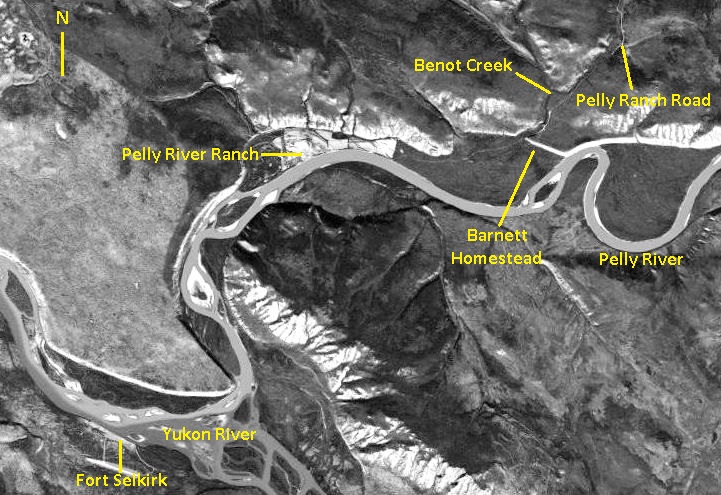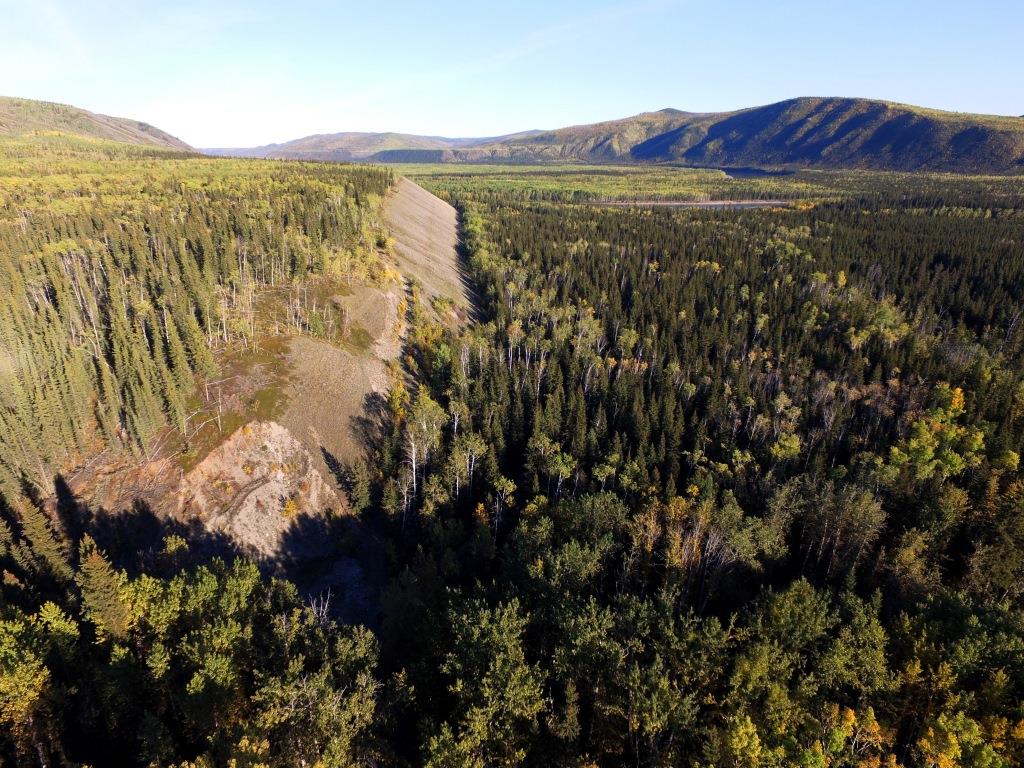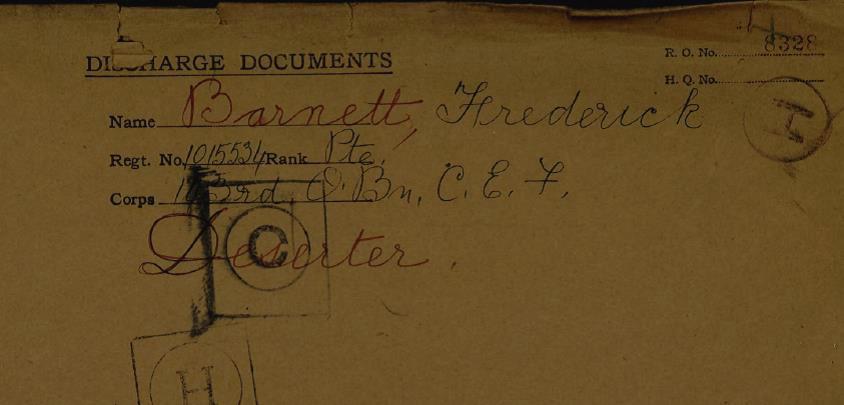On the Pelly Ranch Road about three kilometers from the Ranch property, there is a culvert containing a very small creek with clear, cold water. This is the point where the creek emerges from the hills and onto the Pelly River valley bottom. Not far from the culvert, the creek disappears into the porous soil before it can reach the Pelly River, less than a kilometer away.
This is Benot Creek, inaccurately named by the Geological Survey of Canada geologist Hugh Bostock, who worked in the Yukon from 1931 to 1954. He named it for Frederick Barnett, an American who came to the Yukon on the heels of the Klondike Gold Rush and staked out a homestead near the creek. Just out of sight from the road near where it crosses the creek stand the remains of Barnett’s cabin.

(Yukon Lands Viewer)
Frederick Barnett was born in Lincoln, New Hampshire in 1888. It is not known when he came to the Yukon, but in May 1915 he applied at Fort Selkirk for a 160-acre homestead fronting on the Pelly River six kilometers up the river from Pelly River Ranch. The land inspector reported that the parcel was suitable for agriculture and contained no timber values (timber values on a parcel could sometimes result in an application not proceeding).

(Gord Allison photo)
In January 1916 Barnett’s homestead application was approved. He proceeded to build a cabin in the bush almost a kilometer away from the river. It was at the extreme northwest corner of his described homestead area, or perhaps even outside of it, presumably to be as close to the creek as possible.
Barnett’s cabin shows some skills in building and axemanship, as noted by Dale Bradley of Pelly River Ranch. The flat, axe-hewn inside surfaces of the logs as well as the tight corner joints are quite impressive. It appears, however, that Barnett may have never completed the cabin because there are no obvious remnants of roof logs, either inside the building or leaning against the walls as is commonly seen in a cabin with a collapsed roof.

(Gord Allison photo)
Frederick Barnett signs up for War
There is a good reason why Barnett may not have finished his cabin. His homestead was approved in January 1916 and he likely started building the cabin that spring. However, in April he signed up for a big event – the First World War – that was to change his life and determine the fate of his homestead.
Barnett’s attestation paper (application form) to join the Canadian Expeditionary Force was filed in Dawson and listed his address as Dawson, his occupation as a miner, and his next-of-kin as his friend Joseph Horsfall of Fort Selkirk. Additional information showed that he was single and his parents were deceased.
Barnett was assigned to the 231st Overseas Battalion and was sent out with the second Yukon contingent in June. He was officially enlisted on July 1 at Sidney, BC, where his battalion was training. In January 1917 Barnettwas transferred to the 143rd Overseas Battalion, which became a Railway Construction Battalion. His unit sailed for England on February 17, 1917.
In Barnett’s homestead file, the next correspondence after approval of the homestead application was a letter in July 1920 from the Crown Timber & Land Agent in Dawson requesting information about what work had been done on the land. The more than four year lapse in correspondence was likely because it would have been known that Barnett had signed up for military service and veterans were given some latitude for meeting their homestead obligations.
The reply from the land inspector in Fort Selkirk was that Barnett had not been seen nor heard from since leaving the Yukon in 1916. The inspector reported that Barnett had built a cabin on the homestead property, but that no other work had been done there.
The Benot Creek name
I have known about Benot Creek for years from time spent at Pelly River Ranch. Dick and Hugh Bradley at the Ranch said that it was named for a homesteader who built the cabin there, then went away to the First World War and never returned. There seemed to be a question mark about the name and how to say it – the Bradleys pronounced it like ‘Ber-net’, with a near-silent ‘r’ and emphasis on the last syllable. Their pronunciation was closer to ‘Barnett’, perhaps coincidentally, as I never heard them say that was the name of the man who built the cabin.
When I started researching the homestead, I also wondered about the name. An internet search of Benot showed nothing relevant to Canada, and Canada’s online phone book (Canada411.ca) had only one Benot in the whole country. It seemed highly unlikely that this could have been the homesteader’s name. The breakthrough came with the finding of a file in the Yukon Archives for a homestead upriver of Pelly River Ranch in the name of Frederick Barnett.
With that mystery solved, the next one was how Benot Creek became an official place name that appears on maps. The Yukon Government’s toponymist office (place names specialist) had information that the name was approved in 1968 by the Geographical Names Board of Canada, the federal agency that had jurisdiction at that time. The approval had been based on information supplied by the geologist Hugh Bostock for a man who homesteaded in the area before the 1930s.
The Board’s Secretariat at Natural Resources Canada in Ottawa was then contacted, as that organization has Yukon place names information that is not available in the Yukon. They had additional information in the form of hand-written notes from Dr. Bostock in 1963, including this notation about Benot Creek: “name given me as a long-standing name after an old-timer, by people in Fort Selkirk in the 1930s”. The name was officially approved in 1968.
There is an approximate 30-year gap between when the Benot Creek name was provided to Bostock in the 1930s and when he passed along the information to the Geographical Names Board of Canada in 1963. It is not known if the name was being used unofficially during all those intervening years.
The terms ‘long-standing’ and ‘old-timer’ used by Bostock, as well as Barnett’s friendship with Joseph Horsfall, indicate that Barnett had been around the Fort Selkirk area for a while. However, Barnett was only 28 years old when he enlisted in the military and left the Yukon, so it would seem he hardly qualified as an old-timer. Bostock may have been given erroneous information, but in any event he and/or his informants obviously did not know Barnett’s proper name.
Since the creek was already named for Barnett, it seemed that it should at least be the correct name, and I considered the idea of making a submission to the Yukon Geographical Place Names Board. Barnett was an American and hadn’t lived in the Yukon for very long, but he appeared to have made a commitment to the country by taking out a homestead, and, more importantly, by going to war for Canada.
The personnel record
I was not able to trace Barnett after the war, so did this mean he perhaps also gave his life for this country? A check of the Commonwealth War Graves Commission database of those who died in the First and Second World Wars did not reveal his name.
This research on Barnett was being done at about the time that World War I personnel records were becoming available online from Library and Archives Canada. When his file was finally processed and appeared online, I hoped it would reveal some insight into what happened to him.
The first page of his personnel record revealed that Barnett had not died in the war. The page was a scan of a manila envelope that noted his name, rank, regimental number, and company. This was followed by a single word in big red letters: Deserter. Information in the file stated that he deserted on February 6, 1917, just 11 days before his unit sailed overseas to join the battle in Europe. That ended any further thought about getting the little creek renamed in his honor.

(Library & Archives Canada, Personnel Records of the First World War)
Barnett’s personnel record also referenced a Court of Enquiry, so contact was made with Charlie LeRoss, who runs a website dedicated to the “B.C. Bantams”, as the 143rd Battalion was known. He had little information on Barnett, but said that the personnel record should have the date of a Court of Enquiry, which was normally held for someone who deserted. This was not the case for Barnett, so Mr. LeRoss thought it was possible that since he deserted just days before the Battalion left for overseas, the court may not have been held until it reached there, or was not held at all because the Battalion was broken up once it reached England.
Barnett’s trail disappears
What happened to Frederick Barnett after he deserted his comrades before they sailed toward battle has not been determined. Perhaps he would have thought it wise to get out of Canada and disappear into the United States.
Barnett’s homestead was officially cancelled in September 1921. The area is now a mature mixed forest with cattle trails running across it and a small road to a fish camp on the Pelly River. His cabin walls still stand in the bush near Benot Creek, the remaining evidence of his life there. Perhaps if he had conducted himself more honorably, his correct name on the nearby clear, fresh Yukon creek would be his legacy. For now, the maps will contain the meaningless name of Benot Creek, but perhaps a more appropriate name will be proposed for it someday.
Updated December 20, 2019